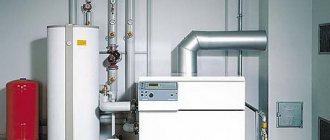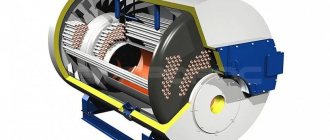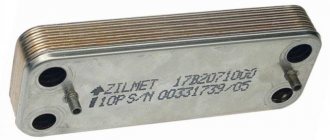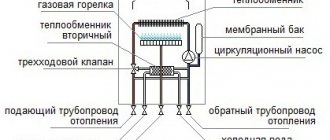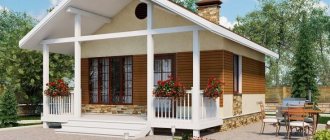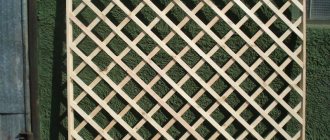Of all types of heating installations operating on solid fuel, the most effective are those in which pyrolysis occurs when burning wood or coal. This is the process of afterburning gases released from firewood or coal during their smoldering, which allows almost all the energy of fuel combustion to be transferred to the coolant. This principle uses a pyrolysis boiler circuit, in which the separation of combustible gas from fuel and its subsequent combustion is realized.
Design and layout of installation elements
Unlike classic solid fuel installations, long-burning pyrolysis boilers provide two combustion chambers instead of a traditional firebox. In the first chamber, slow combustion occurs due to insufficient air. In this case, the fuel begins to release so-called pyrolysis gas, which flows into the secondary chamber along with combustion products. A sufficient amount of air is supplied there, as a result of which the gas ignites and burns, heating the water jacket of the unit.
The location of the two chambers may be different, since pyrolysis-type heating boilers can operate either using natural chimney draft or using forced air supply from a fan. In installations using natural draft, the secondary chamber is located above the primary and air passes through the fuel from the bottom up. With artificially created draft, the main firebox, on the contrary, is located above the afterburning chamber and the air flow is directed from top to bottom. This is reflected in the diagrams below for the design of pyrolysis boilers with different chamber layouts.
About the pellet burner
A pellet burner is a special heating device that produces heat by burning pellets or fuel granules in a boiler. In some cases, these burners use unnecessary dry grain.
There are manual and automatic burners; in automatic burners, fuel is supplied to the combustion hopper using a special auger, and the entire process is controlled by sensors, due to which the device requires minimal control from the user. Pellet burners have found their use not only in everyday life, but also in industry. They are used for space heating, water heating and to meet a number of other needs.
Pellets, or fuel granules, are a special solid fuel that is obtained from wood or agricultural waste by pressing and granulating under high temperatures.
Pellets are an environmentally friendly type of fuel, since when they are burned, the same amount of carbon dioxide is released into the atmosphere as is formed during the natural decomposition of wood
In countries where agriculture and the woodworking industry occupy leading positions, the cost of pellet fuel is much lower than that of coal. The only exceptions are those regions in close proximity to which coal mining enterprises are located.
When burning pellets, hazardous fumes are not released, as happens when burning liquid fuel.
Combustion air supply methods
Increased requirements are placed on the height and diameter of the chimney when the air supply circuit in the pyrolysis boiler involves the use of conventional draft. It should be enough to overcome the resistance of the gas-air path of the installation and the chimney pipe, as well as to create a vacuum in the firebox of 16-20 Pa. You can select the diameter according to the outlet pipe, and the height should be at least 5-6 m.
Forced air supply to both chambers can be carried out in three ways:
Typically, the design of a pyrolysis boiler involves installing a fan in pressure mode. This is explained by the fact that a conventional blower is more affordable than a smoke exhauster, since the latter must extract exhaust gases at high temperatures. For this reason, its structural elements are more expensive.
Leading manufacturers of pyrolysis boilers install smoke exhausters on their products at the exit of combustion products. The reason is to ensure safety for the person who opens the firebox door in operating mode. The smoke exhauster creates a vacuum, so the flame will not blaze through the open opening into a person’s face.
For high-power installations, manufacturers use fans for both types of boilers, at the inlet and outlet of the gas-air duct.
In order to understand how a pyrolysis boiler works, we recommend watching the following video.
DIY assembly
When making a pellet burner with your own hands, it is important to pay special attention to the basket. Often, due to improper implementation, pellets can get stuck. In this case, the combustion process does not follow the required algorithm and the fire returns to the bunker
To eliminate this drawback, you need to look at the upper right part of the figure below. The slot through which the pellets will be supplied does not need to be made solid. It should have holes that are 2 mm smaller than the pellets themselves. It is also worth paying attention to the gap between the bottom of the basket and the back wall. It should be at least 6 mm, but 2 mm smaller than the size of the pellets. The unit where the pellet combustion chamber is separated from the pyrolysis gas combustion chamber must be made with continuous slits. If the burner is designed for a boiler with an area of 150 m2, then the height of the secondary air channels that pass under the bottom of the basket should be 30 mm
In this case, the combustion process does not follow the required algorithm and the fire returns to the bunker. To eliminate this drawback, you need to look at the upper right part of the figure below. The slot through which the pellets will be supplied does not need to be made solid. It should have holes that are 2 mm smaller than the pellets themselves. It is also worth paying attention to the gap between the bottom of the basket and the back wall. It should be at least 6 mm, but 2 mm smaller than the size of the pellets. The unit where the pellet combustion chamber is separated from the pyrolysis gas combustion chamber must be made with continuous slits. If the burner is designed for a boiler with an area of 150 m2, then the height of the secondary air channels that pass under the bottom of the basket should be 30 mm.
In addition to the basket, a scrupulous approach also requires a bunker in which the pellets will be stored. The problems begin with those pellet bins that are made by eye and according to a loose drawing. On the left in the diagram above are the dimensions and drawings of the hoppers that are used in Pelletrons. With a home area of 150 m2, one such bunker is enough for a day. At the bottom right in the same figure is a drawing and dimensions of the combustion chamber. The basis for them was the Pelletron 15 pellet burner. The corridor through which the secondary air will move is best done in the shape of the letter “L”. This is necessary for better mixing of secondary air with pyrolysis gases. This will increase the efficiency of the installation. The combustion chamber will require a special type of steel that can withstand high temperatures. At the same time, welding it at home can only be done with spot welding, since a conventional welding machine will have difficulty warming it up. You will need sheets with a minimum thickness of 2 mm. An interesting design of a pellet burner is shown in the video below.
Manufacturing of a pyrolysis boiler
The efficiency of this type of wood-burning installations has become the reason for their popularity among craftsmen who can make solid fuel pyrolysis boilers on their own from available materials. This process is quite labor-intensive and requires skills in plumbing and welding, a certain minimum of tools and equipment:
- electric welding machine;
- angle grinder;
- electric drill;
- set of locksmith tools.
If you have the skills, tools and a great desire, you can make a unit using the following drawing of a natural draft pyrolysis boiler:
1 – air channel; 2 – door for loading fuel; 3 – secondary chamber door; 4 – direct draft damper; 5 – primary chamber; 6 – top cover; 7 – inlet channel for air supply; 8 – air damper; 9 – pipe for the safety group; 10 – secondary afterburning chamber; 11 – chimney connection pipe; 12 – nozzle; 13 – fire tube heat exchanger.
The material for making the chambers can be heat-resistant alloy steel, but this is an expensive material, so craftsmen take simple carbon steel 5 mm thick. To protect it from high temperatures, the pyrolysis boiler is lined with refractory bricks in the lower part of the furnace. They also need to protect the bottom of the secondary chamber, where the flame is directed. To cover the water jacket, sheet metal 3 mm thick is used, it is welded to the stiffeners made of strip steel. The doors, lids and frames of the openings are made from the same metal.
The boiler device provides heat transfer from flue gases through a fire tube heat exchanger located inside the water jacket. For its manufacture, seamless steel pipes made of carbon steel with an outer diameter of 48 or 57 mm are suitable. The number of pipes should be selected according to the required heat exchange surface area, for which the pyrolysis boiler is calculated.
Considering that the fuel in pyrolysis units burns for a long time (up to 12 hours) and is productive, some owners of classic direct combustion units are wondering whether they can be modernized. Such a conversion of a solid fuel boiler into a pyrolysis boiler is possible, but provided that the furnace of the unit is made of metal and not cast iron. The grate is removed and, using electric welding, a partition is fixed in its place, separating the main firebox and the ash pan, which will serve as a secondary chamber. A nozzle is installed between them. In addition, you will need to organize an air supply to both chambers; you need to make air channels and install them, as shown in the drawing.
As a rule, converting a boiler into a pyrolysis boiler occurs not on factory units, but on home-made ones, this expands the possibilities for improving the design. You can change the nozzle flow area, the dimensions of both chambers or the surface heat exchange area, achieving the best combustion duration and increasing the efficiency of the installation.
Budget option for a summer residence
The gas cylinder, with its round shape and metal thickness, is excellent for making a pyrolysis boiler. It is almost a meter high and has a diameter of 35 cm. These dimensions are enough to create a heating device capable of heating a medium-sized room. The device burns well the most wasteful types of fuel: wood chips and sawdust, raw firewood.
The installation works as follows:
- load through the top or side door and set on fire;
- after a stable fire has arisen, cover with a piston (popularly called a pancake) and a tight lid in which there is a hole for the pipe;
- a limited amount of oxygen enters the firebox through the air duct, causing the pyrolysis process to begin;
- gases rise along the walls of the boiler and burn in the upper part;
- the remaining products are removed through the chimney.
The balloon is cut at the point where the rounding begins. On the side there is a hole for the door, which should close very tightly. Therefore, it is usually used for cleaning, and fuel is loaded from above. The cut part is used for the lid:
- grind the cut to achieve a tight seal;
- make a hole 2–3 mm larger than the air duct pipe connected to the pancake;
- scalded at the bottom with a steel strip.
The piston has a unique design. Its blades are designed to swirl air currents over smoldering fuel, and a round piece of metal welded onto them prevents an open fire from occurring.
The chimney is made of pipes of different diameters: horizontal section - 120 mm, vertical section - 180 mm. This design helps create less active traction and inhibits the removal of gases. The right angle also plays a role in slowing down the combustion process. This ensures pyrolysis and continuous operation of the boiler for 8–10 hours.
A hole is made at the bottom for an ash pan with a door. Its design should ensure a tight fit. You can use a cut piece of the cylinder wall, onto which strip iron is welded around the perimeter. A grate welded from reinforcement is installed a little higher. Residues of fuel fall through it, which are then removed.
A lot of moisture condenses in the vertical chimney pipe, which collects in its lower part. A ball valve is installed to remove water. It is convenient because if it becomes clogged, it can be easily cleaned with a piece of wire.
Calculation of a pyrolysis boiler
The calculation begins with determining the temperature difference, ºС:
Ƭ= (∆T – ∆t) / ln (∆T / ∆t)
In this formula:
- ∆Т – temperature difference of combustion products before and after the heat exchanger;
- ∆t is the difference between the temperatures in the coolant supply and return pipelines.
The resulting value Ƭ is substituted into the formula:
S = Q / k / Ƭ , where:
- Q – design power of the heating installation, W;
- k – heat transfer coefficient, equal to 30 W/m2 ºС.
An enlarged calculation of the power of a pyrolysis boiler (Q, kW) is performed based on the area of the building. Its value must be taken based on the external measurement of the house, the result divided by 10. The meaning of this action is that approximately 10 kW of thermal energy is required to heat every 100 m2 of the building. The result obtained is the calculated power of the heating system, and the heat source is taken with a safety factor. It depends on the region of residence and ranges from 1.1 to 1.5.
Necessary materials
To make any boiler you need metal. It can be sheet (for rectangular models) or a round pipe. Its dimensions and thickness also depend on the purpose and drawings of a particular heating device.
Fireclay brick is necessary for constructing an afterburning chamber. A mechanical sensor will help regulate the combustion temperature of the boiler.
Pipe for chimney.
Tools you will need:
- Bulgarian;
- welding with electrodes;
- measuring instruments (square, level).
Commissioning works
After the assembly of the pyrolysis boiler is completed, it is necessary to check the tightness of the welded joints. The water jacket is filled with water, then air is pumped into it, creating excess pressure. Poorly welded seams will make themselves felt by leaks. Now you can carry out tests, it is better to do this outside, supplying running water from a hose. If a safety group is installed on the unit, then you can fill the boiler tank with water and check its operation at a critical pressure of 2-2.5 Bar. The test order is as follows:
- Attach a temporary chimney, load fuel into the chamber and open the direct draft damper.
- Stop the flow of running water by providing a temporary tap.
- Ignite and start the pyrolysis boiler. As soon as the firewood flares up, the direct draft damper must be closed so that the pyrolysis process can begin.
- Open the secondary chamber door and make sure there is a flame. This requires adjustment of the pyrolysis boiler; you need to achieve an even and stable flame by opening or closing the air damper.
- Close the door and observe the readings of the thermometer and pressure gauge. In a closed water jacket, the process of vaporization can begin when the pressure reaches 1.5 Bar, at which time the temperature must be carefully monitored.
- High-quality welded pyrolysis heating boilers can withstand pressures of up to 3 Bar, but there is no need to set records. It is enough if the safety valve set to a pressure of 2 or 2.5 Bar begins to release steam, then you can open the tap and resume water circulation. The air supply damper must be closed for the fuel to begin to fade.
Be careful when carrying out such tests, there is a danger of scalding with boiling water due to negligence or if the water jacket ruptures.
Safety precautions
Both home-made and factory-made heating devices are prohibited from being installed indoors close to flammable surfaces (in any case, at least 20 cm)
It is necessary to use a pre-furnace metal sheet if the base is not concrete.
Ventilation in the room where the boiler is installed is mandatory (window cross-section of at least 100 cm2).
Do not pour liquid lighter fluid onto smoldering coals.
When adding firewood, in order to avoid the penetration of carbon monoxide into the room, the draft is increased by closing the hole for the supply of secondary air.
It is not recommended to heat residential buildings with homemade boilers. Only utility rooms.
Connecting the boiler to the heating system
The last stage is connecting the pyrolysis boiler and piping it. As with all solid fuel installations, it is necessary to prevent the formation of condensation on the internal walls of the firebox during heating. This phenomenon shortens the service life of the furnace body, since the condensate contains sulfur inclusions and will cause intense corrosion of the metal. For this reason, the piping of the heating boiler must be done according to a scheme that does not allow cold water to enter the jacket during heating.
Below is a classic diagram for connecting a pyrolysis boiler to a heating system with a balancing valve between the supply and return pipelines.
The jumper forms a small circuit in which the coolant is driven by a circulation pump. The piping of a pyrolysis heating boiler shown in the diagram allows water to circulate through a small circuit, warming up along with the unit. The thermostatic three-way valve will begin to add cold water from the system at the moment when the water temperature in the small circuit reaches the set value, usually 45-50 ºС.
The operating temperature in the heating system is in the range of 60-80 ºС; it is rarely necessary to raise it higher. If your home is cool when operating in this temperature range, then you need to look for the reason in the system itself. It makes no sense to increase the temperature; this will only increase the consumption of firewood in the pyrolysis boiler.
Technological process
Before starting calculations, it is advisable to decide on a suitable heater model:
- what functions it should perform (only heating or also as a home kitchen);
- what fuel is most available;
- intended installation location.
Large stoves allow you to heat spacious rooms. Metal units are mobile and can be easily transported from place to place. The brick kiln is always stationary.
If these issues are resolved, you can begin to make a pyrolysis oven with your own hands.
The body of a potbelly stove type can be made from scratch using high quality steel sheets. It is easier to make the furnace body in the form of a rectangle with double walls, filling the opening with sand or water (you will get a water circuit). Another option is to use an existing steel container such as a barrel or gas cylinder.
In the case of a brick building, you will need the skills of a masonry master.
In any case, you will have to make two combustion chambers. One is the combustion chamber, where solid fuel is processed; in the second, processed products are burned, coming into contact with air. Grate bars are installed between the chambers. It is advisable to make the chimney removable, so it is easier to clean.
The dimensions of the future installation depend on the required power. The main element is the combustion chamber. When calculating its volume, it is based on the combustion rate of the proposed fuel and its mass. The load factor is generally considered to be 0.63 (by which the mass of fuel is divided).
Suppose you need to create a metal furnace. You will need the following materials:
- steel sheets grade st. 20 4 mm thick (cutting is best left to specialists);
- steel corners with identical shelves 4x50 mm;
- steel reinforcement with a cross section of 8 mm;
- pipe with a diameter of 60 mm for the blower;
- 120 mm pipes for the chimney;
- one and a half dozen bricks.
You also need tools for the job:
- welding machine with a set of electrodes;
- grinder, drill;
- building levels, tape measure, pencil;
- hammer.
Commissioning
After you have made sure that all the preparatory work has been done, you need to visually inspect for leaks and check the coolant level.
Starting a cold boiler is difficult for several reasons:
- There is no draft in a cold chimney;
- Abundant condensation on the walls prevents the fuel from igniting and creates soot.
First you need to warm up the pipe. To do this, a flame, for example, from a gas or gasoline burner is directed into the hole for cleaning it; newspapers are also suitable. Only after the draft has been established is it possible to ignite the fuel in the boiler. After reaching the optimal operating mode, the dampers that regulate the combustion temperature are adjusted.
At the beginning of work, noise from the movement of coolant through the pipes is allowed, since air pockets have formed somewhere and air is being removed. At first, it is best to run the boiler at full power in order to pressurize the system, so to speak.
After several days of operation, it will be possible to say that the boiler has been started and run-in properly.
Main advantages of the gas generator
Pyrolysis heating boilers using solid fuel have a number of advantages over other solid fuel units, which are as follows:
- When gas compounds burn, no soot is formed, and very little ash is produced, so such a device can be cleaned much less frequently.
- The gas generator maintains the desired temperature much longer than conventional wood combustion units.
- A boiler with a pyrolysis function has a significantly higher efficiency than traditional solid fuel devices.
- The firebox of the gas-generating product is designed in such a way that it is enough to place firewood in the loading chamber just once to heat the home for 24 hours.
- During the combustion process, wood gas interacts with atomic carbon, which, when burned, produces a mixture of H2O (steam) and CO2 (carbon dioxide) - relatively neutral and safe compounds.
- The power of the gas generator can be adjusted in a fairly wide range (from 25% to 100%).
- In a pyrolysis boiler, it is possible to dispose of some types of waste without air pollution (rubber products, polymer products).
Important! The combustion products of a pyrolysis boiler contain much less carcinogenic compounds and harmful substances. This device is safe for health.
The operation of pyrolysis equipment for space heating is influenced by many factors:
- ambient temperature;
- required room temperature;
- presence of insulation in the building;
- type of fuel and its moisture content;
- features of the heating system.
However, pyrolysis solid fuel boilers also have disadvantages:
- need for power supply;
- demands on fuel quality;
- high price;
- big sizes.
These devices are equipped with automation, which means they need a power supply.

